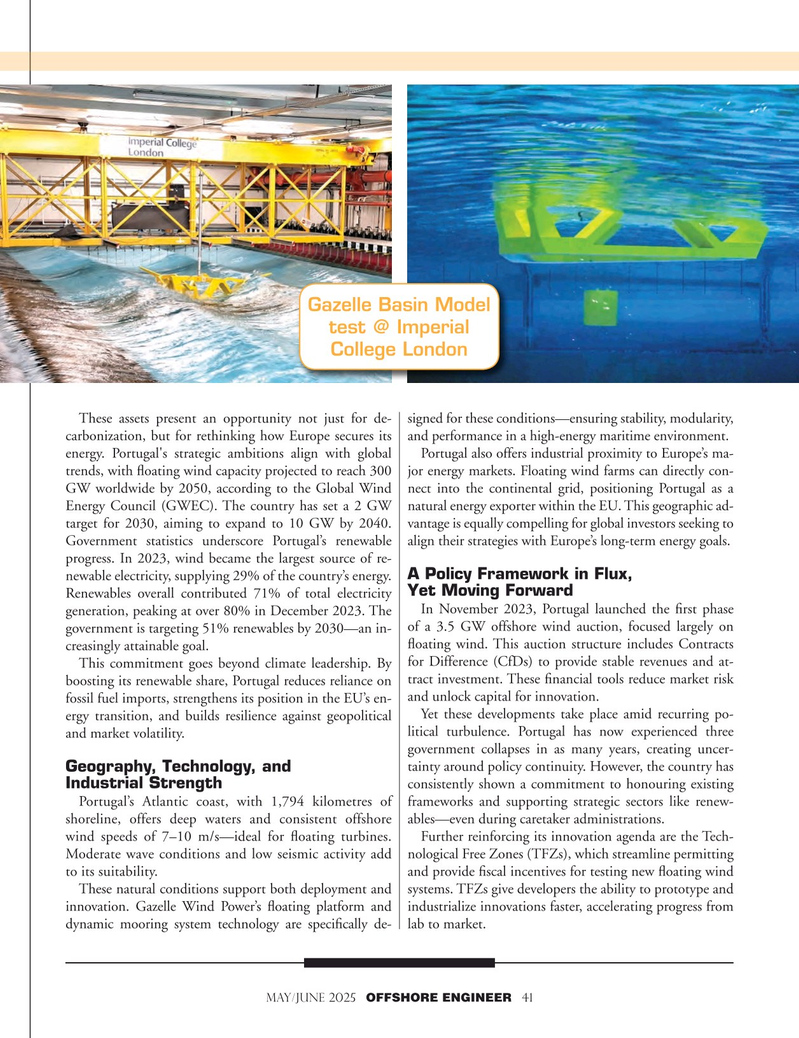
Page 41: of Offshore Engineer Magazine (May/Jun 2025)
Read this page in Pdf, Flash or Html5 edition of May/Jun 2025 Offshore Engineer Magazine
Gazelle Basin Model test @ Imperial
College London
These assets present an opportunity not just for de- signed for these conditions—ensuring stability, modularity, carbonization, but for rethinking how Europe secures its and performance in a high-energy maritime environment.
energy. Portugal's strategic ambitions align with global Portugal also offers industrial proximity to Europe’s ma- trends, with foating wind capacity projected to reach 300 jor energy markets. Floating wind farms can directly con-
GW worldwide by 2050, according to the Global Wind nect into the continental grid, positioning Portugal as a
Energy Council (GWEC). The country has set a 2 GW natural energy exporter within the EU. This geographic ad- target for 2030, aiming to expand to 10 GW by 2040. vantage is equally compelling for global investors seeking to
Government statistics underscore Portugal’s renewable align their strategies with Europe’s long-term energy goals.
progress. In 2023, wind became the largest source of re-
A Policy Framework in Flux, newable electricity, supplying 29% of the country’s energy.
Yet Moving Forward
Renewables overall contributed 71% of total electricity
In November 2023, Portugal launched the frst phase generation, peaking at over 80% in December 2023. The of a 3.5 GW offshore wind auction, focused largely on government is targeting 51% renewables by 2030—an in- foating wind. This auction structure includes Contracts creasingly attainable goal.
This commitment goes beyond climate leadership. By for Difference (CfDs) to provide stable revenues and at- boosting its renewable share, Portugal reduces reliance on tract investment. These fnancial tools reduce market risk and unlock capital for innovation.
fossil fuel imports, strengthens its position in the EU’s en-
Yet these developments take place amid recurring po- ergy transition, and builds resilience against geopolitical litical turbulence. Portugal has now experienced three and market volatility.
government collapses in as many years, creating uncer- tainty around policy continuity. However, the country has
Geography, Technology, and consistently shown a commitment to honouring existing
Industrial Strength
Portugal’s Atlantic coast, with 1,794 kilometres of frameworks and supporting strategic sectors like renew- shoreline, offers deep waters and consistent offshore ables—even during caretaker administrations.
wind speeds of 7–10 m/s—ideal for foating turbines. Further reinforcing its innovation agenda are the Tech-
Moderate wave conditions and low seismic activity add nological Free Zones (TFZs), which streamline permitting to its suitability. and provide fscal incentives for testing new foating wind
These natural conditions support both deployment and systems. TFZs give developers the ability to prototype and innovation. Gazelle Wind Power’s foating platform and industrialize innovations faster, accelerating progress from dynamic mooring system technology are specifcally de- lab to market.
MAY/JUNE 2025 OFFSHORE ENGINEER 41

 40
40

 42
42